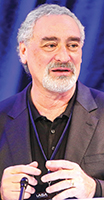
Inside AASA
Morton Sherman on Professional Networking
School Administrator, September 2016

After 25 years as superintendent of school districts in Alexandria, Va., Cherry Hill, N.J., South Orangetown, N.Y., and elsewhere, Mort Sherman wasn’t ready to hang up his hat. In July 2015, he became AASA’s associate executive director of leadership services and awards, a role he sees as a direct extension of the work he did leading school systems.
The AASA department he manages has initiated an aspiring superintendent program, the national superintendent certification program, the urban superintendents academy, the AASA Collaborative, the digital consortium and the superintendents’ summit on personalized learning. All of these convene school system leaders for skill development and career growth.
The following interview with Sherman by assistant editor Kristin Hubing has been edited for length and clarity.
What is the goal of AASA’s professional development programs?
Sherman: We’re focused on the skills and dispositions of leadership that are necessary to create a culture that supports change and innovation to improve student learning.
We also provide content through programs to support and encourage superintendents. We provide networking opportunities — the ability to talk openly with colleagues, in person or online, about the work they do. And we help leaders stay at the cutting edge of the work that’s going on across the country. Superintendents need continual improvement, or what Steve Jobs called “serial improvement.”
How does your past experience inform this work?
The superintendent position is growing more complex. I know what it’s like to be in meetings five or six evenings a week, to make calls about snow closings at 4 a.m. I understand it, I lived it. So that gives me great empathy for what superintendents are going through, which is helpful as I think about how to support them. At the same time, I am respectful of the position so I can be the listener. My role continually evolves because the needs of our members continue to evolve.
Has personal technology raised the stakes?
The social media aspects of today’s jobs have compounded both the opportunities and the difficulties. It’s given me a profound respect for the changes superintendents go through. The work we do needs to be continually refreshed to suit their changing needs.
In what ways are you connecting leaders?
Through social media such as Voxer, a messaging and walkie-talkie app for team communication; EduPlanet21, which is a secure online platform where educators network within communities of practice; and Twitter, where superintendents gather monthly for #SuptChat.
You’re exposing them to leading thinkers?
Programs have featured education thought leaders such as Linda Darling-Hammond, Heidi Hayes Jacobs, Jack Naglieri and Yong Zhao, but the participants themselves are major contributors to each other’s development. There’s such a wealth of experience and knowledge out there among our superintendents. We need to learn from each other. Superintendents are our thought leader practitioners.
Why is networking important to superintendents?
In each town there are lots of doctors and lawyers and teachers. There’s only one superintendent. And the job may not be the same as for somebody in the town next door. It’s a very isolating and isolated kind of position.
I was never an evangelical AASA member as a superintendent, but I felt strongly connected to my colleagues. I would have been jumping out of my skin in excitement at the opportunity to sit over time with a small group of superintendents focused on something like personalized learning. It would have allowed me to share ideas candidly with nobody reporting back to the community or board.
I truly believe that AASA is uniquely positioned to form this wonderful network of opportunities for superintendents. And as the lead superintendents organization in the country, we have a responsibility to provide these opportunities.
*Inside AASA is a new monthly feature about AASA services and products and the staff members behind them. Read full versions of the interviews
here.*